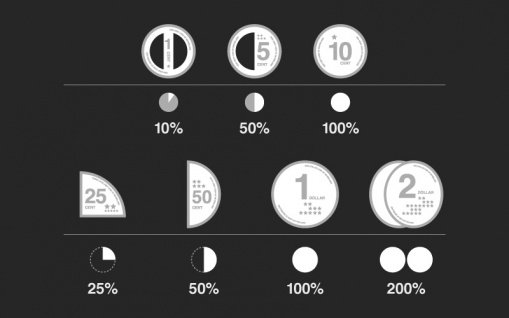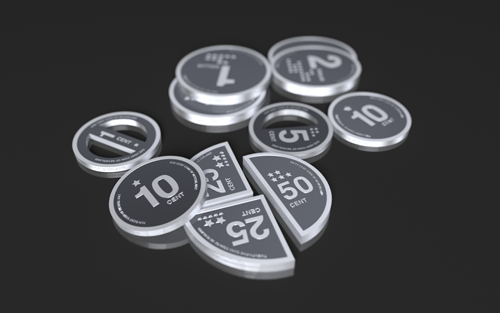You know when you go to another country and have no clue what the coins of the local currency are worth? I always end up with a giant handful of international coins, which doesn’t go well when I try to spend a Euro in Canada. The US vending machine won’t take my Canadian quarters either, or my pesos.
Designer Mac Funamizu puts an idea out there that might solve the woes of international visitors. Use wedges and proportions to indicate how much the money is worth:


Nevermind the increased production costs, storage, and people cutting themselves on coin wedges. They look awesome. Plus – the one- and five-cent pieces can double as bottle openers.
[via Cool Infographics]

 Visualize This: The FlowingData Guide to Design, Visualization, and Statistics (2nd Edition)
Visualize This: The FlowingData Guide to Design, Visualization, and Statistics (2nd Edition)

Spanish coins?
Let me share a secret – large parts of the world are ouside of the US, actually most of the world is non-US.
Since 2002 most countries of the european union share a common currency called Euro.
Kicking the Dollar’s ass ever since btw.
Right now a euro buys you $1.50
Did he say “Spanish Coin”? You know the Peso is the current currency of Mexico right? No need to get all bent out of shape.
I would not say in this way, but I was surprised, too, that you were able to pay in Spanish coins. This is no langer possible since 2002. The euro is the legal currency for 326 million people in Spain, Portugal, Italy, Malta, Greece, Cyprus, Slovenia, Slovakia, Austria, Germany, France, Luxembourg, Belgium, the Netherlands, Finland, Ireland. Bulgaria, Bosnia-Herzegovina and 14 African states have fixed exchange rates with the Euro. Denmark and the three Baltic states think about taking the Euro as the legal currency.
Wake up.
Oh, I forgot Kosovo.
Somebody got up on the wrong side of the bed this morning. Fixed cranky pants.
Hey, I still have Franks, Deutch Marks, and Reals, but that’s just because I like to collect coins. (Of course, I wouldn’t put them in vending machines these days, but pre-2002? Maybe.)
Anywho… I was just wanting to make the comment that when my friends come to the US, they are all confused as to why the nickel is larger than the dime, which is, itself, smaller than a penny (although because the penny is a different metal, this is less of a problem for many).
Most countries that I’ve visited (with the exception of Canada, which uses the same size pattern as the US) have a larger-is-worth-more logic with their coins, restarting the size with a change in either coin color or shape.
… oh and never mind, too, the price burden caused by building and retrofitting new coin acceptance machines to vending machines, toll booths, etc. (which will likely be shown in an increased costs to users).
Not true in Brazil – my memory of this was confirmed at an interesting gallery of world coins at coins.about.com. I also noticed (on the first couple of pages) that Belize, Bangladesh, Barbados, and Australia don’t have monotonically increasing coin sizes either. But then again, Bangladesh has some really cool coin shapes so that makes up for it. (And Aruba has some square coins – neat!)
If these coins themselves never take off anywhere, one option could be to make a little coin-purse of different zippered pockets *Marked* with these images. When you travel, you could sort the local coinage into the pockets marked by these interpretive images.
Hmm. Maybe I’ll make one for myself for my own local money. :)
@Cat – i smell product idea!
Pingback: somerandomdude: Infographic Coins for International Visitors https://flowingdata.com/2009/12/17/infographic-coins-for-international-visitors/ — Some Random Dude
Pingback: Daily interesting articles | Aww Dip
A lot of countries use 20 cent coins rather than 25 cents, so the coin would have to be a slightly smaller wedge.
While this is a cool concept, it would also never be practical since there are floating exchange rates for the vast majority of currencies. The proportions would be in constant flux and possibly end up far different than the coin indicates. It makes more sense to teach everyone about exchange rates and teach them to use their phone’s calculator.
Or to build off Cat’s idea, build a site that generates a printable visual conversion chart to take with you based on current exchange rates. The proportions displayed should probably be rounded for ease of use (i.e., sans calculator). And, of course, a mobile-friendly version of the site for the environmentally-conscious.
Why would a floating exchange rate matter? I think the proposal is that in any given country, these shapes would be used for the coins. So the 5-centavo / 5-kroner / 5-whatever coin *shape* would be the same in any country. It doesn’t matter how it compares to the Euro or the Yen or the Dollar. All that matters is the proportion to other coins in that country.
If you live close enough to the canadian border (say, in Michigan) you can often use your Canadian coins in stores. But yeah, vending machines and parking meters are too cranky to accept them.
They also happen to be great for blind people.